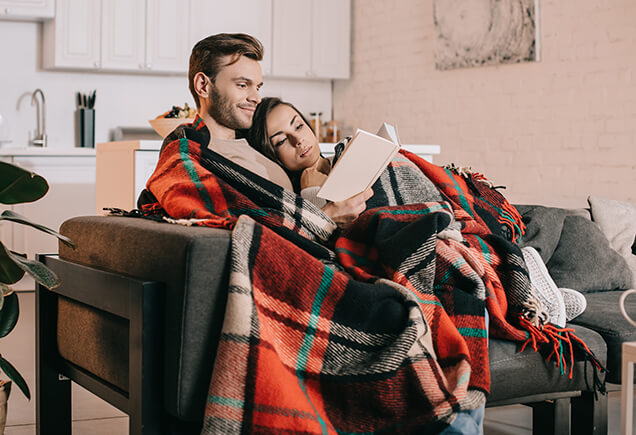November 17, 2021

What is the Ideal Temperature for Your Furnace during the Winter?
There are two integral factors when choosing the temperature for your home heating this winter. The first is to ensure that you and your family are comfortable throughout the season. The other is to avoid the high costs that are often associated with heating a home in an area like St. Louis that has extremely cold winters. With that in mind, let us explore some strategies that you can use to strike a balance between comfort and savings.
Your Ideal Winter Temperature Is Not Fixed
Having a fixed temperature setting that is used 24 hours a day is wasteful for the average home. In fact, the EPA advises that the average home can save up to 10% just by lowering their thermostat 10 degrees for an eight-hour period each day. There are even greater savings available when you consider that the usual household will have at least three phases within a 24-hour period in which a distinct temperature can be set: away from the home, at home and awake, and at home and in bed.
Programmable and Smart Thermostats
While it is possible to control the various temperature periods of a day with a manual thermostat, it is not recommended. The inconsistences introduced through manual operation will all but ensure that you cannot achieve the energy savings promoted by the EPA. The good news is that programmable thermostats are relatively inexpensive and easy to install. Most units account for at least three periods, and most offer more than that. Support for weekends is a ubiquitous feature as well.
If you are willing to invest a little more in your home thermostat, then you may want to consider a smart unit. Smart thermostats support scheduling just as programmable units do but also have advanced features, such as the ability to adjust your schedule based on machine learning. Another popular feature is a Wi-Fi connection, which lets you adjust the temperature while you’re away from home.
Optimal Winter Temperature While You Are Home and Awake
Energy.gov advises that 68 is the optimum winter temperature when you are home. This is a general rule that was achieved through data. The winter temperature found comfortable by the average person was compared to the average cost to maintain that temperature during the season. Everyone is different. You may run warmer or cooler than the average person and will thus need to adjust your baseline as much as several degrees.
Optimal Winter Temperature While You Are Home and Asleep
A consensus among sleep doctors is that the best sleep temperature for the average person is 65 degrees, and many of them recommend a setting as low as 60 degrees. Generally, the lowest temperature you find comfortable will be most conducive to a good night’s sleep. We also recommend using winter-specific bedding. Heavier bed sheets and a quilted blanket, for instance, can let many people enjoy bedtime temperatures in the 50-60 degree range, and that can add up to some significant savings long term.
Optimal Winter Temperature While You Are Away
This is the period where the greatest savings are available and where many Americans go wrong according to EPA statistics. While you are away from your home, the temperature should be as low as possible while still being safe. The safe temperature ranges from 40-55 degrees depending on where you live. In the St. Louis area, a conservative guideline is 50 degrees Fahrenheit during the day and 55 degrees at night. Be aware that if you are a pet owner, you will need to maintain the temperature as if you were home.
A low thermostat setting while you are away is another great reason to invest in a smart unit. There are thermostats that can use Wi-Fi to determine that you are the last one to leave the home and adjust the temperature. Just prior to the kids returning from school, it can anticipate their arrival and heat the home. Wi-Fi can come in handy when you’re on vacation too. If the forecast calls for an ice storm and freezing temperatures, you can override your usual temperature to ensure the house is a bit warmer that night.
Lower Your Temperature by Dressing Warmer
A common mistake that people make is choosing an indoor winter temperature and then dressing accordingly. If you are walking around in shorts and a T-shirt, chances are you are throwing money away. A more cost-effective approach is to dress in heavier comfortable clothing and dictate your baseline temperature based on that. You can also use blankets when you’re sitting on the couch or at your computer.
Lower Your Temperature by Humidifying Living Spaces
Winter air holds less moisture than summer air and is thus drier. The lower the relative humidity in your home, the cooler you will feel. An effective way to feel warmer is to use a humidifier. While whole-home humidification is an option, most households will do just fine with portable humidifiers that can be brought into whichever rooms are currently in use.
Lower Your Temperature by Space Heating
While using space heaters throughout a home is generally not economical, many households can selectively use one or two to reduce their heating bill. This may be easier to accomplish in smaller households where all members will often be congregated together. If you and your partner will spend a couple of hours on the couch watching TV prior to going to bed, then you can set your nighttime temperature now and use a space heater to warm your current space.
Maintain Your Heating System for Optimal Performance
How well your central furnace system is functioning will determine how big your heating bill is this winter. Heating experts recommend a furnace tune-up in autumn prior to the heating system being used, and that service can pay for itself by lowering seasonal costs by as much as 10%.
It is also a good idea to monitor your system throughout the season. Check HVAC filters at least once a month, and replace them whenever you can see the dust accumulating. Ensure that vents are clean and open. Never close vents in unused rooms unless you have a zoned system capable of handling such pressure changes. Return vents should ideally be positioned over windows. Use deflectors in cases where they are not. You should also use ceiling fans in the clockwise direction in every room you have the option. This will even the warmth and allow you to set the thermostat temperature as low as possible.
Your Local Heating Pros in St. Louis
Scott-Lee Heating Company was first founded in 1978 and has now been serving St. Louis and the surrounding areas for more than 40 years. We are your local heating experts, and if you need professional assistance with your furnace or other heating equipment, our team is here to provide it. Our company also installs, services, and repairs air conditioning systems, and we specialize in indoor air quality solutions as well. Call us today or contact us online to learn more about our services and to schedule an appointment.
